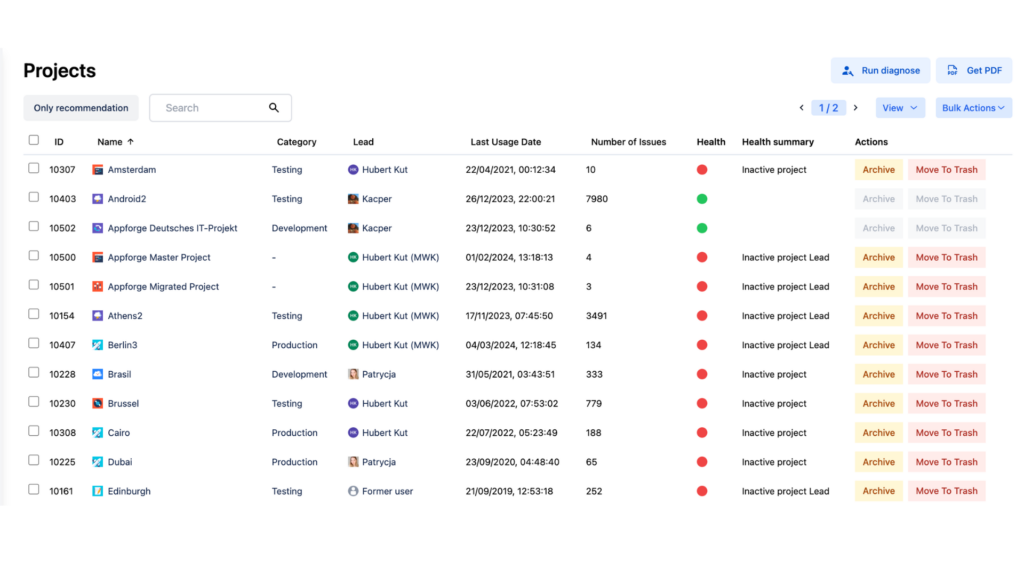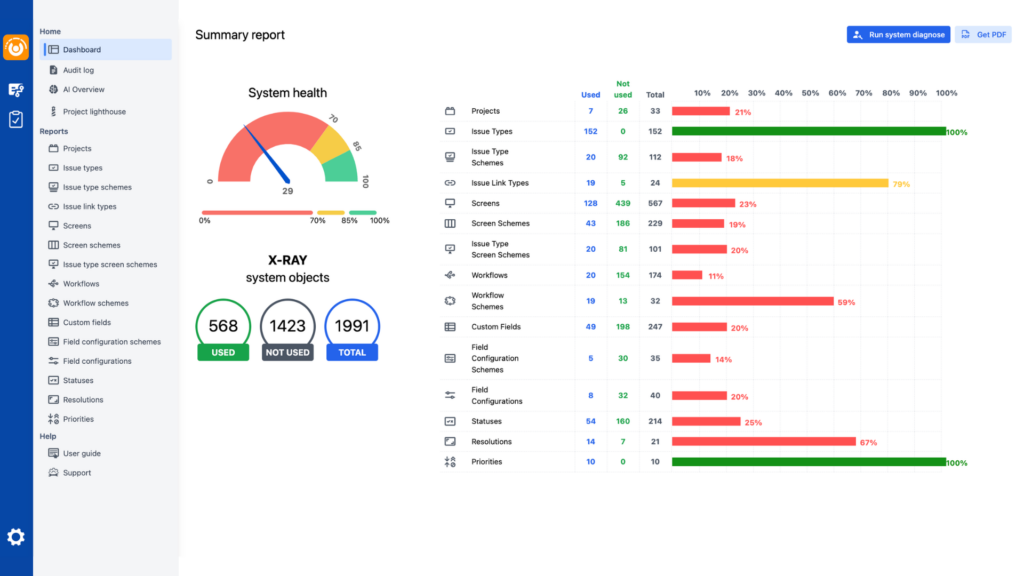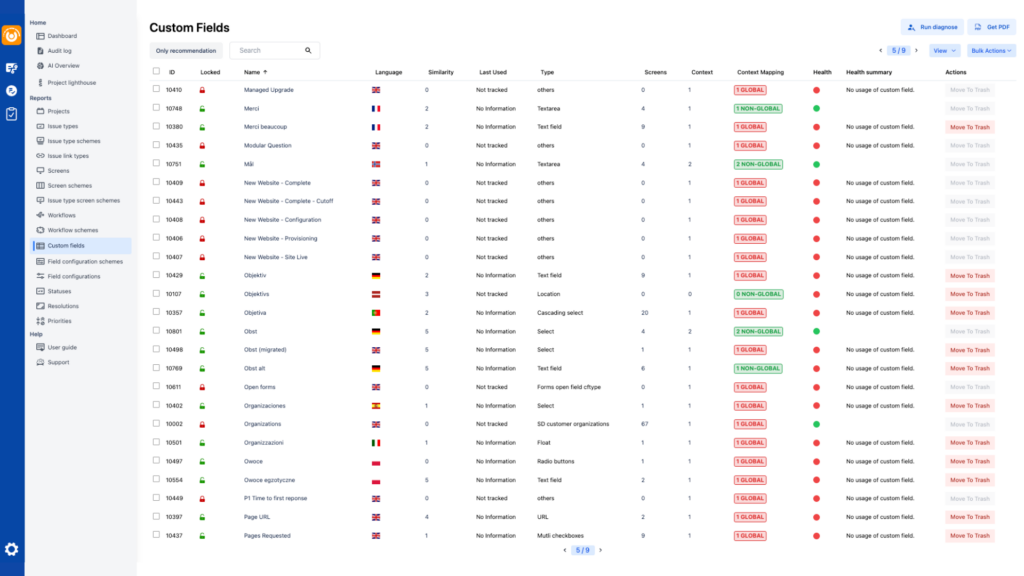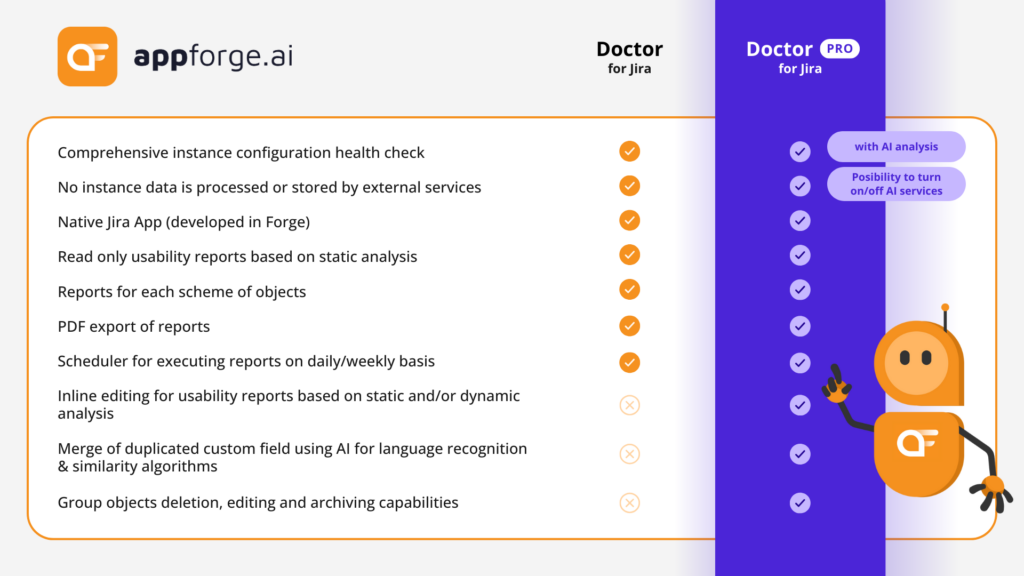Most of the companies have such a problem with migrations. They do not have a time for doing data governance, proper data governance.
Most of them push that to the Christmas time or holiday season when they are floating in the topics or there is a freeze for the changes on production.
And that was the time when Atlassian consultant could clear their configuration – unused object, project or archive project. How can you make it faster with Doctor Pro for Jira?
The phases of migrations
Cleaning up your house, your car is something that you don’t like to do. Because it’s time consuming.You need to know what to do, how to clean it up.
Doing cleanup it’s tough because what if I delete some production data? You would like to avoid it, right? So you need to be really careful about cleaning up the production instance, because in Jira word if you delete the object, it’s gone.

Migration to the cloud has multiple stages. So that’s the typical way you migrate an instance from a server data center into the cloud. You need to do the instance assessment, then you need to plan, prepare, test, migrate, and launch.
Typically, Atlassian Consulting would visit the client’s instance to examine its configuration, determine the number of installed apps, evaluate the number of project objects, and so on. Then, based on these details, they can estimate how much time the migration might take.
Instance assessment is one of the most time consuming part of any migration.
Imagine if, instead of spending 5 to 10 days on an instance assessment—a standard timeframe cited by the industry’s leading players and top-tier Atlassian consultants—you could reduce it to just one day or even mere moments with just one or two clicks. This is the efficiency brought to you by application Doctor Pro for Jira!
How is it possible to do that?
How to migrate a client in just one day?
Our tools – Jira Data Center, as well as for both Jira Pro and Basic in the cloud are designed to dramatically cut down the time needed for instance assessments—from the usual 5-10 days to just a single day or even half a day.
Additionally, they streamline post-migration processes, ensuring proper data governance and eliminating duplicate objects without any manual intervention, all thanks to automation enabled by our app.
While the preparation, testing, and actual migration phases remain essential, our comprehensive toolset significantly accelerates these processes.
In fact, we recently facilitated a migration for a moderately sized client—with less than 20 projects, 84,000 tickets, and 700 objects—in just one day, showcasing the efficiency and effectiveness of our solutions.
Prepare to migration
Let’s dive into the specifics. If you’re involved in migration as part of your daily work, planning a migrations, or if you’re a Jira administrator, consultant, or IT support professional, here’s what you need to know:
For migration, suppose you’re currently using a server or data center. In this case, you’ll need to install two essential tools. The first is the Jira Cloud Migration Assistant — an exceptional tool that works seamlessly with our specialized application, Doctor Pro for the Jira Data Center version. These two applications together provide a robust framework to support your migration efforts.
You start Jira cloud Migration Assistant in one day, and, in parallel, you turn on Doctor Pro For Jira to get the report.Then you try that on the sandbox or migrate to a newly created instance and then see the results.
After completing the migration, you can install Doctor Pro for Jira Cloud Edition. This tool will assess your newly migrated instance, identifying any duplicated objects or areas that may require further cleanup. This is particularly useful for ensuring your new cloud environment is as streamlined and efficient as your server was, if not more.
Example:
One of the clients decided against cleaning up his server instance before migration because it was nearing the end of its lifecycle. Instead, we opted to migrate everything to the cloud using the Jira Cloud Migration Assistant. Post-migration, we could then address the cleanup directly in the cloud environment, where it’s possible not just to clean up but also to archive data.
Then he said – I don’t want to leave any data behind because I don’t know if it’s used. Even though your Doctor Pro for Jira says that that project is not used for 3 years, our regulation is saying that we need to keep the data for 5 years so we move it to the cloud, and then we will clean it up there.
Doctor Pro for Jira
Are you curious whether any of your projects have lain dormant for the last 365, 760, or 730 days? With a single click, our tool allows you to instantly generate a report detailing the last time each project was accessed, along with the number of issues associated with it. This functionality was the missing piece for my team and me in the market, something we’ve always needed.
Hence, we’ve introduced what we call the ‘Health Summary.’ This feature encapsulates recommendations drawn from the collective century of experience my team and I have in Atlassian consulting. We’ve harnessed our extensive brainstorming sessions and embedded all our collective insights into this tool.
Significantly, this app is crafted using Forge, meaning it integrates seamlessly into your cloud instance without exporting any data externally, maintaining the integrity and security of your data unless you opt otherwise.
Projects
It’s crucial to maintain awareness of project activity and ownership. One may ponder whether any projects within the system have remained inactive over the past one or two years, or if there exist projects devoid of any ticketed issues. Additionally, the presence and activity status of project owners is another vital consideration, especially when organizational changes occur frequently.

Addressing such queries, one could benefit from a comprehensive report offering a snapshot of current project health, identifying inactive projects, ticket-less projects, and verifying the continued association of project owners with the organization. This facilitates effective data governance, enabling informed decision-making regarding which project owners to contact for necessary changes, particularly in global configurations.
This approach simplifies data governance, making the management of project details and owner engagement straightforward and efficient.
Dashboard
Our dashboard encapsulates a comprehensive overview of all schemes and objects present within your Jira instance. To reiterate, we guarantee that no data is transmitted externally; all processing occurs within the confines of your Jira environment, thanks to the native Forge app integration.

Upon your initial visit to a client, after installing Doctor Pro for Jira, you’re presented with an insightful report. This report not only highlights findings but also offers recommendations derived from our collective century-plus experience within the Atlassian ecosystem. Our seasoned insights aim to guide you towards optimized data management and operational efficiency.
Custom fields
Managing custom fields within Jira can be complex, particularly as deleting these fields equates to the removal of their associated data. In our approach, we leverage AI analysis to streamline this process without compromising your data’s integrity.
Importantly, we emphasize data privacy and security: no personal or sensitive data is stored on our end. We solely process metadata, such as labels from your custom fields, screen names, and scheme names, without accessing the content of your tickets or other sensitive information.
To aid in this, we employ several AI algorithms designed to assist with the cleanup process efficiently. These algorithms focus on optimizing your Jira setup while maintaining the utmost respect for data privacy and security.

We’ve developed a suite of AI algorithms designed to streamline the cleanup process within your Jira environment.
One of the key algorithms we utilize is language recognition, leveraging Google’s advanced algorithms to detect the language used within your Jira instance. This feature, as of March 2024, enhances the accuracy and relevance of your data management.
Another significant algorithm focuses on identifying similarities, revealing potential duplications in tickets through AI-based analysis. This allows for a customizable threshold setting, where you can specify, for instance, a similarity criterion of 90% or 80%. The result is a detailed report indicating the degree of similarity among data entries, enabling you to make informed decisions about data consolidation.
Merging custom fields
This tool isn’t limited to mere deletion or editing; it facilitates the combination of multiple custom fields, even those with the same name but in different languages. For example, a field labeled ‘ops’ in Polish, corresponding to ‘fruits’ in English, can be merged, provided they are of the same field type.
This integration is intelligent, ensuring that only fields of the same type are merged, preserving data integrity and context. Moreover, the process encompasses more than just merging; it extends to transferring data, checking filters, and evaluating contexts comprehensively.
By automating what would traditionally be a labor-intensive manual process, our solution not only saves significant time but also enhances the accuracy and efficiency of managing your Jira instance.

Last steps – migration production
After migrating your instance, let’s assume you’ve already conducted a thorough cleanup on the server or data center. Now, it’s akin to having driven a brand-new car off the dealership lot—pristine, polished, and impeccably maintained. Naturally, you’d want to maintain its prime condition for as long as possible.
This is where maintaining your instance becomes crucial, much like caring for that new car. By continuously utilizing Doctor Pro for Jira, you can effortlessly oversee the data governance and maintain the integrity of your instance. This tool acts as your personal maintenance system, ensuring your Jira instance remains in top shape, just as you’d keep a luxury vehicle in impeccable condition through regular care and attention.
Group object removal
The process of managing Jira configurations, such as screen removal, can be notably streamlined with the right tools. Take the case of a recent client who faced the daunting task of managing over 5,000 screens, of which 3,500 were unused. This client managed to clean up the surplus in just 15 minutes—a feat that might seem insurmountable if approached manually.
While some may argue that similar results could be achieved through scripting, such as using a REST API with a Python script, the efficiency and simplicity offered by specialized Jira tools are incomparable. Crafting a Python script to remove 3,500 screens not only requires significant coding expertise but also time for development and testing.
Prescription for better JIRA data governance

Group objects removal
Imagine the comprehensive management of various Jira schemes could be streamlined and made less time-consuming. Consider this: typically, it takes about six seconds to eliminate a single object within Jira. Yet, with the right tools, managing issue type screen schemes, for example, becomes significantly more efficient.
Let’s say you have 51 of these schemes. With a specialized tool, you could access a report, apply only recommended actions, and then adjust your view to handle 100 objects simultaneously. In this scenario, out of 51 objects, 31 could be identified as unnecessary or unused, ready for deletion.
Complete health check
Upon the installation of Doctor Pro for Jira, users can initiate a system diagnosis to obtain a comprehensive report without manual navigation through each scheme. Typically, a system administrator would need to manually review each scheme, relying on personal expertise to determine the usage of various screens. However, this tool consolidates all relevant information onto a single page.
For example, in the context of project management, the tool displays critical information such as project ownership, last active dates, ticket volumes, and tailored recommendations. If a project like ‘Berlin’ shows recent activity but the listed owner has left the company, the administrator can swiftly assign a new owner directly within the interface. Following a system refresh, the updated project status is indicated, enhancing administrative efficiency.
Automated cleanup
Frequently, tasks such as automation, scripting, or integration require the use of REST API, ScriptRunner, or similar scripting tools, which in turn necessitate the IDs of various Jira objects. Unfortunately, Jira does not directly display these IDs in its user interface, making their retrieval a time-consuming task as it often involves navigating to the URL of each object to find its associated ID.
In an improved approach, a tool or enhancement in Jira could present the IDs of all objects transparently within the interface itself, saving significant time. By simply accessing a specific section within the tool, users could quickly identify the type and ID of any object they need.
All languages supported
Custom fields represent one of the most intricate components within Jira, especially when dealing with multinational or multilingual environments. Consider a scenario where an enterprise-level company based in the USA acquires a company in Berlin, which uses a Jira system entirely in German. This situation presents a unique challenge: merging custom fields that are essentially identical but exist in different languages.
The solution extends beyond mere translation or consolidation of text fields. It involves the more nuanced challenge of merging select lists — a task that, while more complex, can significantly streamline the combined Jira environment. This capability allows for a unified system where duplicated fields, even when presented in different languages, are intelligently merged, fostering a more integrated and efficient workflow post-acquisition or merger.
Summary
Companies face time-consuming Jira migrations. Doctor Pro for Jira emerges as a significant time-saving solution, reducing migration efforts by 79%. It streamlines the assessment, planning, and cleanup phases from days to hours, enhancing efficiency. The tool’s capabilities extend to managing complex issues like custom fields and object IDs, particularly beneficial in multinational settings, simplifying the merging of duplicate fields across languages.


